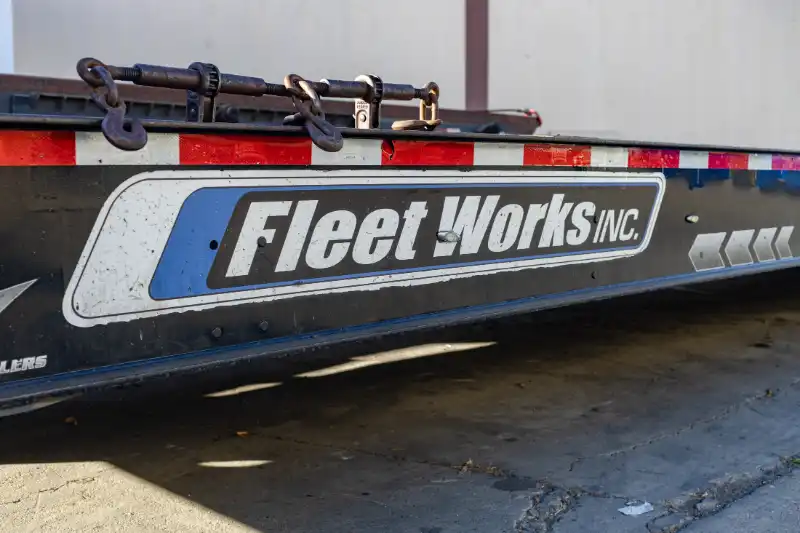Transport Trailer Breakdown: Choosing the Right Setup for Hauling Heavy Equipment
When transporting a 50,000-lb excavator to a Riverside job site before dawn, choosing the wrong trailer is like trying to lasso a tornado. The right rig keeps you legal, protects the equipment, and eases the drive on California’s tricky bridges and grades.

Why Your Transport Trailer Choice Matters
When you’re staring down a 50,000-lb excavator that has to reach a Riverside job site before dawn, picking the wrong transport trailer is like trying to lasso a tornado with dental floss. The right rig keeps you legal, protects the iron, and saves you from white-knuckle miles on I-5’s Tehachapi grades. In California’s maze of low overpasses and weight-posted bridges, every inch of deck height and every pound on the scale counts.
Know Your Cargo Before You Roll
Hauling begins long before the tractor fires up. Grab three numbers and detail them in your logbook:
- Operating weight.
- Overall dimensions.
- Center of gravity.
Those figures determine whether a step deck trailer can fit under utility lines or if a lowboy trailer is the safer option.
Trailer Types Demystified
Flatbed
Great for palletized loads and cranes that can ride tall, but adding beavertail ramps means you’ll surrender deck length—fine for forklifts but lousy for bulldozers.
Step Deck Trailer
One drop provides 10–20 inches of headroom, ideal for mid-sized wheel loaders. Check the main deck rating—import builds often cap at 43,000 lb while domestic steel pushes 53,000 lb.
Lowboy Trailer
The heavyweight champ of heavy haul. With a 22–24 in. loaded deck height, you breeze under most 14-ft California structures, and a booster axle lets you laugh at an 85,000 lb gross.
Removable Gooseneck (RGN)
Detach, drop, and drive the machine right on—no circus ramps needed. An RGN can stretch to 50 ft for scrapers or piling rigs and slashes load time when LA traffic is breathing down your tail lights.
Extendable & Multi-Axle
Jobs that weigh 100,000 lb or stretch past 60 ft require stretch decks or 3- to 5-axle combinations. These rigs absorb weight and distribute it so that Caltrans won’t red-tag you.
California Bridge Law Math—Simplified
Golden State law mirrors the federal Bridge Formula but adds wrinkles. In plain English, wider axle spreads enable the transportation of larger legal loads. A five-axle tractor-semitrailer can gross 80,000 lb only if the kingpin-to-rear-axle distance hits the sweet spot on Caltrans’ chart. Squeeze tandems too tight, and you’ll donate lunch money at the Cordelia scales. Add a flip axle or jeep dolly to push the weight off the tandems when your transport trailer exceeds 60,000 lb.
Permit Planning: Oversize and Overweight
California Highway Patrol issues single-trip permits for anything over 8 ft 6 in. wide, 14 ft high, or 80,000 lb gross. Ignore the paperwork, and you’ll bleed profit faster than a leaking hydraulic hose. Use Caltrans’ CalRoute database to pre-clear bridges and snag automatic pilot-car flags. Oakland-to-LA routes often choke at the Grapevine—request SR-99 when your load is tall but light.
Load Securement & FMCSA Compliance
Deck choice is half the battle; holding the iron in place is the other. FMCSA compliance—specifically 49 CFR 393.130—demands at least four tie-downs on any tracked or wheeled machine over 10,000 lb, plus one extra for every additional 10 ft of length. Securing devices must be rated and tagged; chains showing more than 20% wear are sent directly to the scrap yard. Remember: regulations require a downward force of 20 percent of the load’s weight—cheap binders won’t cut it.
Maintenance Makes the Money
A seized pony motor on your lowboy trailer can turn an easy off-load into a yard-dog rescue. Build a weekly ritual:
- Verify air-ride bags hold pressure overnight.
- Grease detachable neck pins and RGN kingpost bushings.
- Drain moisture from ABS valves—coastal humidity murders sensors.
- Torque wheel studs after every axle swap.
- Inspect oak deck boards; a split plank can punch a D-ring during tensioning.
Cost vs. Capability: Finding ROI
A $130,000 lowboy trailer with a flip axle may feel pricey, but if it saves two permits a month and avoids one $5,000 citation, it pays for itself in under two years. Conversely, leasing a step deck trailer can bridge capacity gaps during seasonal harvest hauls without tying up capital.
Pro Tips from the Road
- Paint the last 12 in. of each chain fluorescent yellow—instant inspection cue.
- Mount a trailer axle calculator app on the dash; shift axle slides at the customer yard, not at the scale house.
- Carry a 50-ton hydraulic jack—waiting for mobile service on I-5 eats daylight.
- Keep a spare glad-hand gasket under every brake chamber clamp.
- Laminate Caltrans’ weight chart and keep it with your permits.
Wrapping It Up
Choosing the perfect transport trailer is a complex calculation involving deck height, axle math, and load securement rules. Nail the combo, and you’ll glide past weigh stations, shave hours off load times, and shield your profit margin. Skimp on planning, and you’ll hemorrhage dollars at every checkpoint from Oakland to Riverside.
Ready to Haul Smarter?
Still scratching your head over specs? Swing by Fleetworks in Oakland, Riverside, or Los Angeles. Our techs live and breathe heavy haul and can tailor a setup that fits your fleet like a custom wrench. Call today and roll out with confidence.
Shop Locations
Fleetworks Inc. is proud to have expanded to three locations across California, providing a wide-range of truck & equipment repair & fleet services from our locations in Oakland, Santa Fe Springs, Riverside, & the surrounding areas.
Santa Fe Springs Location
14011 Marquardt Ave, Santa Fe Springs, CA 90670
Riverside Location
*Equipment Service & Repairs only*
1310 Dodson Way, Riverside CA, 92507
